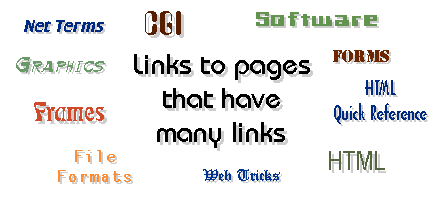 |

Links to Pages That Have Many Links
... and they may dissappear
by R. Glass
Revised:
| There are three things that usually lead to a heated conversation: |
- Religion,
- Politics,
- Editors and word processors.
|
People usually have very strong feelings about those three items. Since you are reading this, chances are that you are interested in writing HTML. The question becomes, What are you going to use to write HTML?. Whatever you decide upon it should be easy to use and intutitive. It is a tool and you should not have to think about the tool when you are using it.
Yes, you can write HTML with any old editor (Notepad, Turbo program editors, EDIT) or a word processor provided that you save the file as an ASCII (DOS) text file. In truth, you really should get yourself a true HTML editor (or macro package for a word processor). These programs (or tools) will usually have buttons or menus for the various HTML tags and you won't have to remember all those sTraNgE tags.
Many companies today are offering shareware or time - limited (stops working after a specified date) versions of their software. This gives you an opportunity to test drive what is out there before investing any money. Here are a few webpages that either allow you to obtain copies or provide links to the software distributor.
Here are some pages on HTML syntax and standards.
If you would like a quick reference to the various HTML tags , then these short synopsis is for you. You may want to download it and keep it handy so it can be viewed when off line.
Remember, you can always see the HTML by choosing an option from your browser.
- Netscape: Choose View followed by Document Source.
- Internet Explorer: View followed by Source.
|
| Remember, you can test the markup (result of the HTML) by either clicking on the HTML file or using the Netscape option FILE - OPEN.
|
When you really want to get fancy, check out some fancy web tricks at:
Eventually, you might want to add some images to your pages,
A down and dirty treatment of image maps (server side) can be found at:
Forms allow you web page to capture data and information from the reader. A form consists of HTML tags coupled with a Common Gateway Interface (CGI) program to capture input from a user.
If the CGI program already exists and is available to you, then all one needs to do is design the form. You can design a form, view it but the submit will not do anything. You must be on line and be submitting the data to a CGI program.
What is CGI you ask? CGI is not a programming language. It is a definition and protocol (some information passed as envronment variables) between the web server and the operating system the web server is running on. Depending on the server, the program itself can be written in a variety of different languages. On our Novell server, CGI can be written in Perl 4 (Practical Extraction and Report Language) and a very old line numbered BASIC. On some of the Microsoft Windows servers, DOS .BAT and Visual BASIC can be used as CGI languages. A true UNIX server, CGI can be written in any language running on that system (including shell scripts).
Just to round out this page, I am including a reference to frames. Frames is the technique where the browsers can split the screen into several windows with a different page in each window.
Want a definition on a computer/net term? Try:
Knowing what a file is by its extension is neccessary.
R. Glass
|
